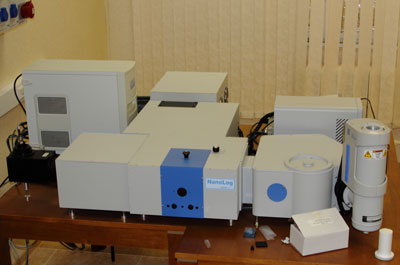
|
Overview
The NanoLog® series of spectrofluorometers are specifically designed for research in nanotechnology and the frontiers of nanomaterials. Based on the world-wide proven technology of the FluoroLog®, the NanoLog® detects fluorescence in the near-IR from 800 to 1700 nm (optional multi-channel detection to 2 µm, single-channel detection to 3 µm), with visible and UV options possible. With the NanoLog® comes specially designed software ideal for classifying SWNTs, performing energytransfer calculations, and saving custom routines and instrument layouts. A complete spectrum can be scanned as fast as a few milliseconds, and a full excitation-emission matrix scan can be taken in as little as seconds.
Features
- Rapid excitation-emission matrices in seconds
- High sensitivity in near-IR with InGaAs array
- High resolution
- Eases qualification and quantification of species and families of SWNTs
- Compatible with variety of detectors from UV to near-IR: Photomultiplier tube for highest sensitivity and timeresolved analysis, Popular, cost-effective single-element InGaAs,
Multi-element CCD array for fast data-acquisition
- Resolve mixtures of quantum dots simultaneously
- Perform energy-transfer experiments
- Modular design for your ideal experimental setup
Specifications
- 450 W intense broadband cw xenon lamp for bright excitation from UV to near-IR
- Full excitation-emission matrices in seconds
- Symphony II InGaAs array detectors: 800-1700 nm; 256 x 1,512 x 1, and 1024 x 1 pixel formats as small as 25 µm pitch; noise as low as 650 erms with liquid-nitrogen cooling for best signal-to-noise ratio; optional thermoelectric cooling; extended range option (1.1 - 2.2 µm)
- iHR320 emission spectrograph: focal length = 320 mm; f/4.1; dispersion = 2.31 nm/mm; resolution = 0.06 nm (with slit); software-controlled triple-grating turret (all measured with 1200 grove/mm grating)
- Solid-state near-IR detectors, photomultiplier tubes from UV to near-IR, time-correlated single-photon counting lifetime measurement (100 ps to 1 ms, UV to near-IR), phosphorimeter (1 µs to > 10 s, UV to near-IR), and frequency-domain lifetime measurement (10 ps to 10 µs, UV to near-IR) are also available
|

![]()
